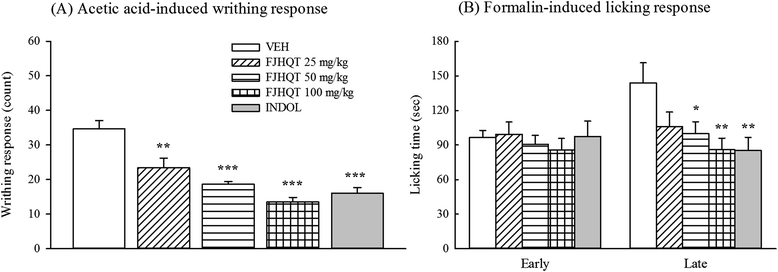Anti-nociceptive, anti-inflammatory and toxicological evaluation of Fang-Ji-Huang-Qi-Tang in rodents
- PMID: 25652206
- PMCID: PMC4322796
- DOI: 10.1186/s12906-015-0527-5
Anti-nociceptive, anti-inflammatory and toxicological evaluation of Fang-Ji-Huang-Qi-Tang in rodents
Abstract
Background: Fang-Ji-Huang-Qi-Tang (abbreviated as FJHQT), composed by six medicinal herbs including Radix Stephania Tetrandra, Radix Astragali, Rhizoma Atractylodis Macrocephalae, Radix Glycyrrhizae, Rhizoma Zingiberis and Fructus Ziziphi Jujubae, is a frequently Chinese prescription for treating painful and inflammatory disorders such as rheumatoid arthritis. When Radix Stephania Tetrandra was misused with Aristolochia species, acute or chronic nephropathy caused by aristolochic acid was happened. Thus, the present study was aimed to identify Radix Stephania Tetrandra and performed the pharmacological and toxicological evaluation of FJHQT extract in rodents.
Methods: Radix Stephania Tetrandra was identified by macroscopic and microscopic observation, and the content of tetrandrine in FJHQT extract was measured by high performance liquid chromatography. Then, the pharmacological activities of FJHQT extract with respect to clinical use was investigated with acetic acid-induced writhing response, formalin-induced licking response and carrageenan-induced paw edema. Finally, we evaluated the subacute toxicology of FJHQT extract after 28-day repeated oral administration in rats.
Results: Radix Stephania Tetrandra was correctly used in FJHQT extract, and the content of tetrandrine in FJHQT extract was 2.5 mg/g. FJHQT extract produced a pronounced and dose-dependent antinociceptive and anti-inflammatory effects in three above models. FJHQT extract after 28-day repeated administration did not caused any hematological, biochemical and histological change in rats.
Conclusions: We suggest that FJHQT extract is a high safety index Chinese medicine for antinociceptive and anti-inflammatory application when Radix Stephania Tetrandra was correctly used in FJHQT. Its antinociceptive and anti-inflammatory mechanism might be related to peripheral nociceptive pathway such as prostaglandins.
Figures






References
-
- Wu YJ. Overview in the clinical and experimental research of Fang-Ji-Huang-Qi-Tang. Chinese Med Modern Distance Education of China. 2012;10:163–4.
-
- Li W, Sun YN, Yan XT, Yang SY, Kim S, Lee YM, Koh YS, Kim YH. Flavonoids from Astragalus membranaceus and their inhibitory effects on LPS-stimulated pro-inflammatory cytokine production in bone marrow-derived dendritic cells. Arch Pharm Res. 2014;37:186–92. doi: 10.1007/s12272-013-0174-7. - DOI - PubMed
Publication types
MeSH terms
Substances
LinkOut - more resources
Full Text Sources
Other Literature Sources
Medical

